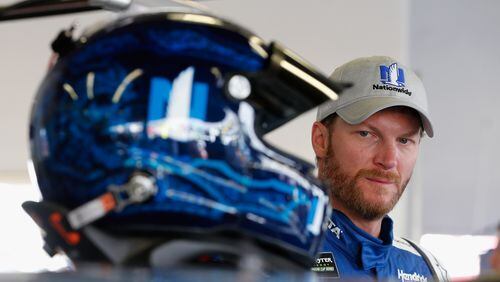DAYTONA BEACH, Fla. – The racing press was ready to break for lunch, always a highlight of any Daytona 500 media day.
But first the assembled content producers and bloggers were invited to view a video introducing the newest sponsor of NASCAR’s signature series, Monster Energy drinks.
What followed was an enhanced interrogation technique disguised as public relations.
The Monster Energy women flanked the stage. They were the objects of a small fuss when they first showed up on the scene in their tight, low-cut cut outfits. (What, haven’t the outraged among the racing fans ever seen a NFL cheerleader or NBA dancer? They really should pop their heads out from beneath the hood more often).
Loud, heavy music replaced the oxygen in the room. Frantic scenes of Monster Energy’s various interests flashed on the screen: Knotty tatted-up folks fighting each other in cages; young daredevils doing unwise things on motorbikes; more attractive women. And I’m not sure but there may have been a few subliminal images of a hog butchering dropped in there.
No doubt, racing is going through another metamorphosis. Each one is more challenging for those of us of a certain age.
Jeff Gordon is driving the pace car Sunday. God, I’m old.
For a sport that goes around in circles, big time NASCAR racing always seems to be at a crossroads. Certainly it is at another one now with Sunday’s Daytona 500 ushering in the 2017 campaign.
The headline on a recent Wall Street Journal story – “NASCAR, Once a Cultural Icon, Hits the Skids” – would lead you to believe that not a whole lot of positive stuff followed.
Television ratings and track attendance continue to dip. According to Sports Media Watch, which compared viewership of 29 races in 2015 to 2016, 22 of those experienced steep declines (15 of them by double digits). Monster Energy reportedly bought in to its sponsorship at a significant discount once Sprint went away. Popular stars like Gordon and Tony Stewart have moved on. And the biggest star of all, Dale Earnhardt Jr., is coming back from serious concussion issues that cloud his future. All very tough personalities to replace. Meanwhile, the core demographic of stock car racing gets ever older – never a good thing in the advertising world.
There is the hope that Monster Energy’s brand image might attract some younger, non-jaundiced eyeballs to racing.
And attempting to add more juice to the sport, NASCAR more than did the usual tinkering with its championship format – it made an extreme, fundamental change to how its races are run. They will be broken into three segments, with bonus points awarded to those running up front in each. The idea is to give fans races within a race and prompt the drivers to compete even harder over the entire length of the event.
Perhaps it smells slightly of a desperate gimmick. But, honestly, it has at least created a bit of curiosity, which is an improvement. It had to try something. There is a potential here for making the racing better – and isn’t that the point?
Stock car racing has lost a significant part of its core, its soul and its place in the American sporting landscape. All that will be very difficult to turn around.
Sunday’s Daytona 500 is an important trial for the latest big changes imposed upon racing, a sport at a crossroads again.
About the Author







